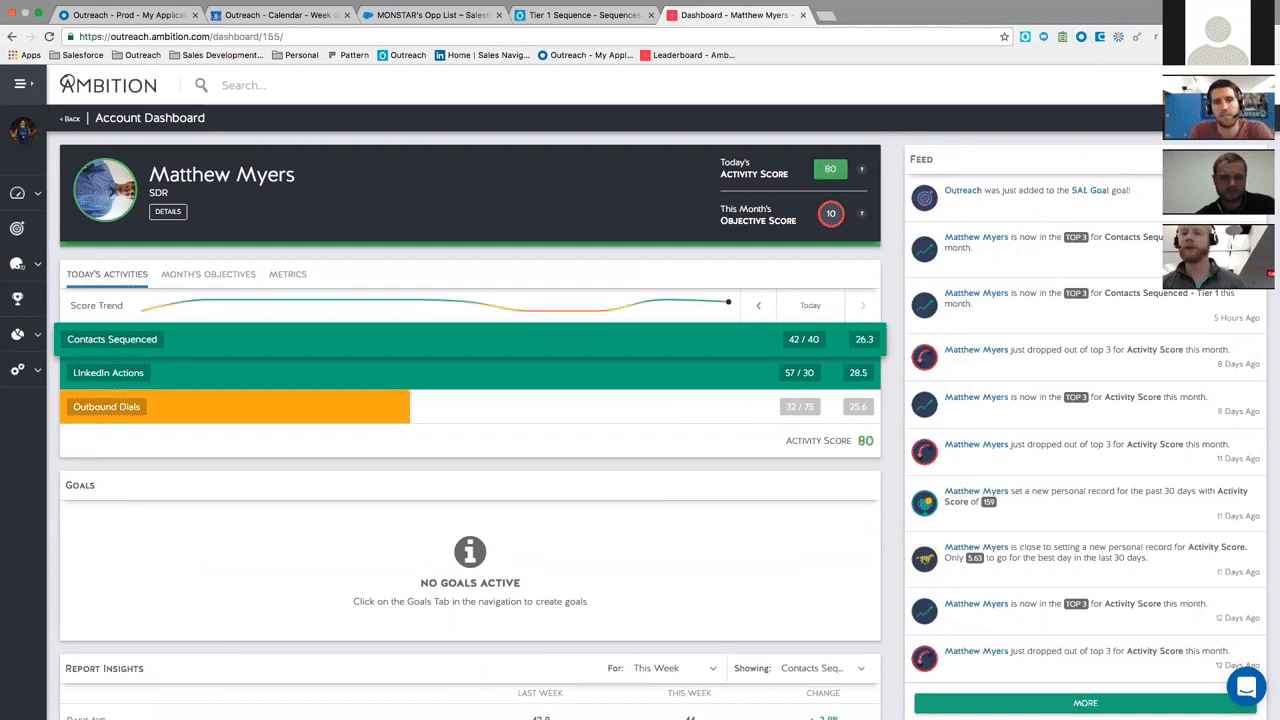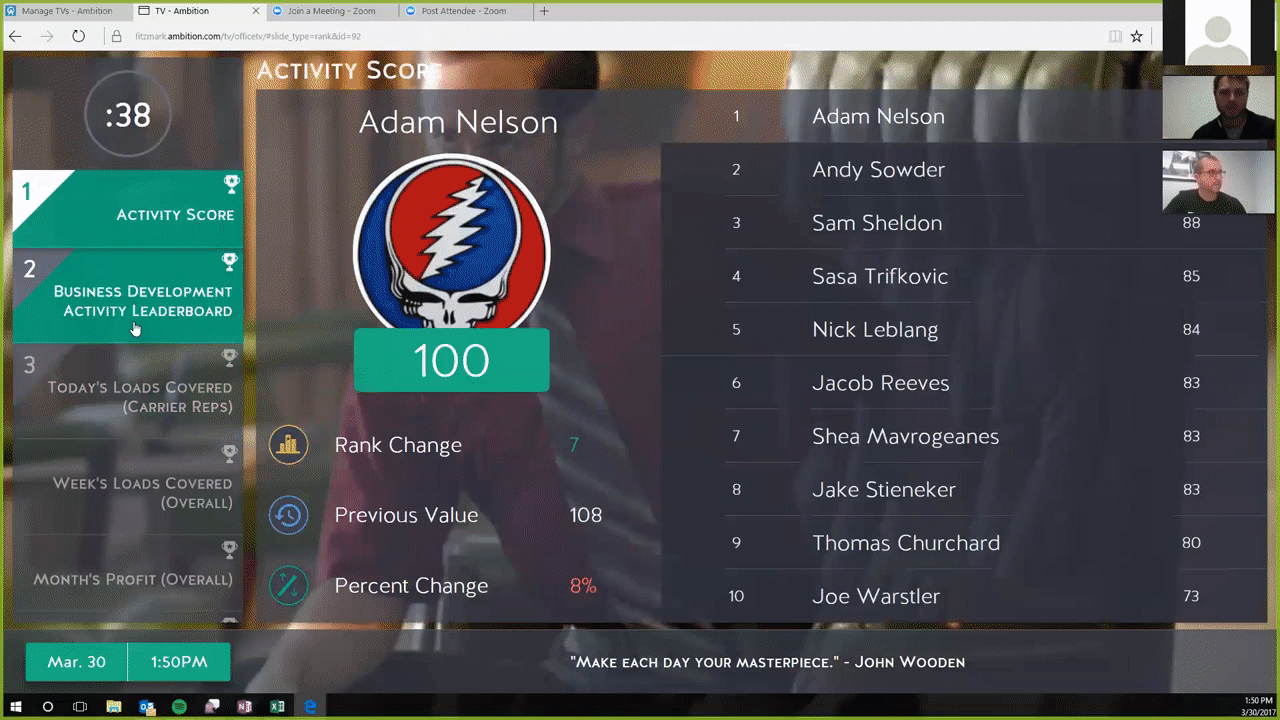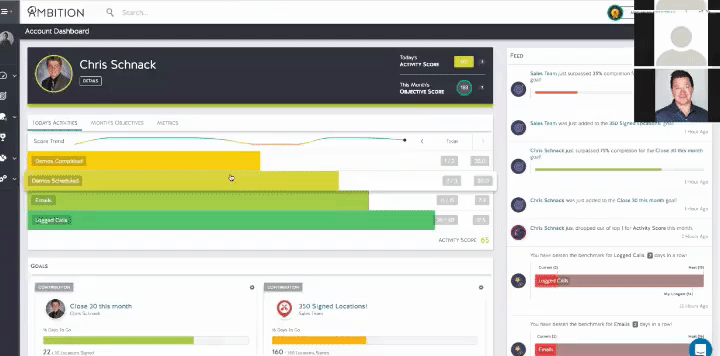As a sales leader, you will inevitably face periods of adversity where your team is tracking way behind quota.
The deeper you go into the quarter or fiscal year, the more limited your time to turn things around becomes. If you lack a gameplan, it's time to develop one. Pronto.
The Fast-Track for Fixing Sales Performance
The following playbook takes 40 business days to fully implement, but you'll start seeing results as soon as you begin the setup process. Follow it to a tee, and you'll see guaranteed short-term turnaround with long-term positive impacts.
Ready to get started? Let's kick things into high gear and start accelerating revenue at the rate required to hit your number.
Weeks 1-2. Align KPIs & Objectives
Agile sales management creates accountability by aligning effort throughout the sales organization, first by establishing clear, compelling goals for reps. Next, by enforcing punishments and rewards for meeting effort metrics and goal acquisition targets consistently and impactfully. The goal is to create a personal investment in sales KPIs at the rep level, so that individuals feel a profound sense of responsibility for their own success.
The 5 Steps to Success
- Create S.M.A.R.T. Goals.
- Use transparency to create accountabilit.y
- Establish “Where are we going.”
- Develop healthy competition.
- Critique privately.
To align your short-term activities with long-term goals, start by reviewing your closed won opportunities, then work backwards through the sales funnel to find key activities and behaviors that drove deal progression through each stage of the sales funnel. The behaviors that most frequently lead to positive outcomes are those worth benchmarking and tracking.
Visual Aid: Outreach Sales Development KPIs [Watch Ambition Walkthrough]

If cold calls are what drive initial prospect meetings, then establish daily cold call benchmarks for your appropriate roles. If client referrals are the most efficient way to turn sales qualified leads into warm opportunities, then codify that into your sales process as a 2nd KPI. And so forth.
For monthly objectives, focus on revenue (or if a rep is not directly responsible for revenue, then a similar overarching goal ala 'qualified prospect meetings set'). Lastly, work in 1-2 efficiency metrics such as calls to first meeting, sales cycle length, and so forth.
The Philosophy Behind the Strategy
ExecVision CRO Steve Richard Agile sales management is about hard-wiring that mentality directly into your sales culture. Once you bring data transparency to key performance metrics, you can use benchmarks, incentives, goal-tracking and timely coaching to create powerful feedback loops for hitting objectives. These goals should span individuals, teams, and departments, and touch the various levels of your sales funnel - such as activity metrics, revenue goals, and efficiency KPIs.
A sales force that is inspired with clear, attainable goals and clear transparency of how to achieve them creates sales leadership nirvana - an organization that is personally accountable and internally driven to excel.
Weeks 3-4. Create Visibility & Feedback
As a manager, you cannot manage what you cannot measure. Use data tracking, visibility and automation to ensure KPI accuracy, foster directional awareness and create meaningful performance feedback loops. Similarly, your modern sales force needs to see clear goals, directives, roadmaps, and feedback to achieve maximum performance output.
The 5 Steps to Success
- Publicize goals & objectives.
- Continually update attainment.
- Broadcast contributing KPIs.
- Flatten your silos.
- Praise publicly.
The target of a manager should be to make an obvious correlation between the aligned goals and objectives (more on this soon), and the specific output of individual reps. By establishing clear visibility to rep performance on the underlying funnel activities and metrics, continual feedback with a consistent message can be developed. Agile sales managers use feedback loops with both automation and regular check-in points to focus, inspire, and develop their teams.
Visual Aid: ChowNow Productivity Quadrant [Watch Ambition Walkthrough]

The Philosophy Behind the Strategy
In his Sales Influencer Series interview, Sandler Sales Management Training Expert Marcus Cauchi invokes The 3 Signs of a Miserable Job to set forth his 5 elements of a poor sales culture:
- Anonymity.
- Immeasurement.
- Irrelevance.
- Stagnation.
- Isolation.
In sales, great sales people love to be measured. Bad sales people want to hide. If bad sales reps dominate your culture, then no one is succeeding. What's relevant to sales managers is the need to set expectations, challenge people to be measured, critiqued and developed, and tell dissidents to go kick rocks.
Weeks 5-6. Create Elite Sales Culture
Millennials are now the largest workforce demographic. Sales organizations are segmenting roles and functions like never before. Technology is now a critical part of every sales professional's day-to-day workflow. All told, there is massive volatility across the inside sales landscape. How you harness the fast-evolving people, processes and platforms within your sales culture can either empower or devastate your sales organization.
Visual Aid: Fitzmark's TV Leaderboards [Watch Ambition Walkthrough]

Returning to Marcus Cauchi's interview - every inside sales organization is going to develop a culture one way or the other. Either the culture will be the conscious design of the sales leadership - or in will develop on its own in the void left by leadership.
The 5 Steps to Success
- Inspire more than motivate.
- Recognize progress.
- Praise the impact of small wins.
- Share positive feedback publicly.
- Avoid generic praise - seek emotional response.
In today's inside sales organizations, elite VPs and Managers are taking full command over culture by placing an emphasis on professional development, public recognition, and performance-based incentives that include not just financial rewards, but opportunities for internal career growth, mentoring, and networking with prestigious business leaders. The War for Talent adds a premium to the development and retention of sales talent - the inside sales leaders that win are maximizing their new talent via clear roadmaps and retaining top talent via compelling rewards systems.
The Philosophy Behind the Strategy
Agile sales management applies core directives from The Progress Principle across the entire front office. According to The Progress Principle: 1) Sense of progress is #1 rep motivator - over pay and recognition. 2) High-performing teams share 6X more positive feedback than others. 3) 28% of small wins trigger powerful emotional responses in reps.
In sales, there’s a direct link between elite sales culture and results. Ultimately, agile sales management works because it gives top executives leverage to multiply culture. Inspiring performance is not a once-a-month pump up speech or an incentive blitz - it is an ongoing, proactive series of goals, challenges, and check-points that keeps all stakeholders engaged. The end goal: empower sales leaders to unify culture and process.
Ambition: Visually Drive Sales Revenue
Here at Ambition, we know this exact struggle like the back of our hand. This scenario is what drives many of our clientele to adopt our platform.

If you're looking for a software solution that automates and empowers each step of this gameplan, check out Ambition. For more inside sales management resources, check out the following eBooks - free to download on the Ambition Academy.
- The Agile Sales Management Guide
- The Winner's Guide to Running Effective Sales Contests
- The Sales Performance Index
No matter what, remember that the path to revenue growth for 2017 and beyond starts with you. Define your ideal inside sales culture, create built-in accountability for your reps, and set up micro-incentives to cultivate success. Let's make 2017 the year your inside sales organization makes culture its unfair competitive advantage.
 Back
Back



